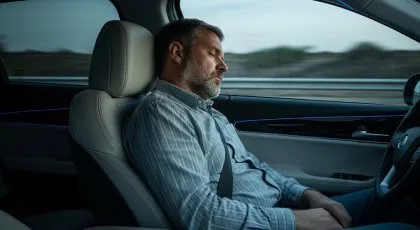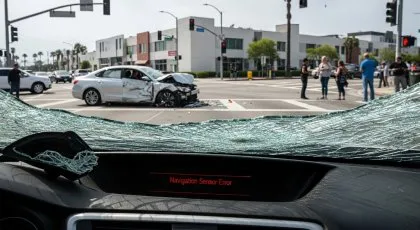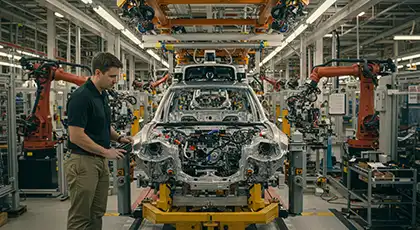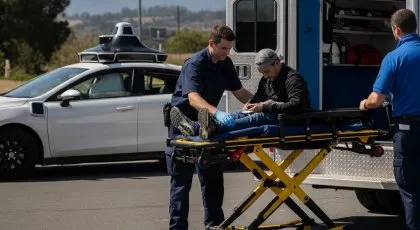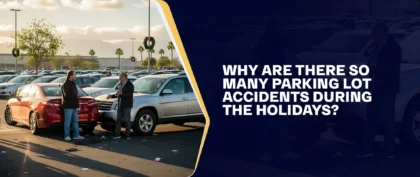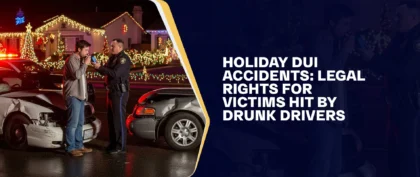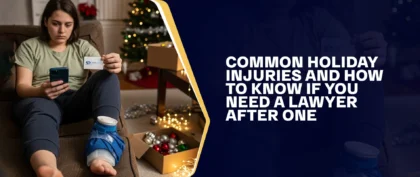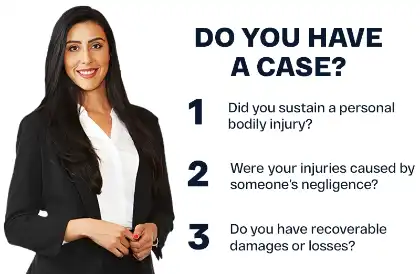TL;DR: In 2024, NHTSA recorded 544 driverless vehicle crashes, averaging about 1.5 per day. Accident rates vary by company and technology, with contributing factors including sensor limitations, adverse weather, and human-automation interaction errors.
Table of Contents
Driverless vehicles, once seen as futuristic, are now operating on public roads in cities across the U.S. In 2024, the National Highway Traffic Safety Administration (NHTSA) recorded 544 crashes involving driverless systems, averaging about 1.5 accidents per day. While the number of incidents has risen as companies like Waymo and Cruise expand their fleets, experts note that the increased number of vehicles in service naturally results in higher crash totals.
The risk is not uniform; the rate of self-driving car accidents differs by manufacturer, technology level, and operating environment. Early studies suggest self-driving cars may reduce certain types of crashes, but sensor limitations, unpredictable road conditions, and human-automation interaction still create hazards. As technology develops, regulators and safety advocates continue to push for stronger oversight to enable these systems to handle real-world driving challenges.
If you are injured in a driverless vehicle collision, our California self-driving car accident lawyers at Arash Law are available for a free case review. Fill out our contact form to learn about your legal options.
Key facts on driverless vehicle accidents:
- NHTSA reported 544 crashes in 2024 (1.5 daily average).
- Accident rates vary by company and vehicle type.
- Waymo has reported a high number of ADS-related crashes since 2021.
- The Society of Automotive Engineers (SAE) found that autonomous vehicles had about 9.1 accidents per million miles, compared to 4.1 for human-driven vehicles.
- Sensor, weather, and road conditions remain major risk factors.
- Liability can involve multiple parties, including manufacturers.
Understanding Self-Driving Vehicles
Self-driving technology has the potential to improve road safety, but accidents still happen. Like any collision, these incidents can cause injuries, deaths, and property damage, just like any traffic crash.
A challenge with crash data is defining what constitutes a “self-driving” vehicle. Researchers often use SAE’s six levels of driving automation:
- Level 0 (No Automation) — The human driver performs all driving tasks.
- Level 1 (Driver Assistance) — Features like cruise control assist the driver.
- Level 2 (Partial Automation) — The system can handle steering and speed, but the driver must stay engaged.
- Level 3 (Conditional Automation) — The vehicle drives itself under certain conditions, but a human must take over if needed.
- Level 4 (High Automation) — The car can drive itself in specific areas without human input.
- Level 5 (Full Automation) — The vehicle can handle all driving tasks in any condition, with no driver needed.
ADAS (Advanced Driver Assistance Systems) covers Levels 1 and 2. These systems can help with tasks, like steering or braking, but the driver must stay fully alert and in control. Generally, cars on the road, like many Teslas, use ADAS.
ADS (Automated Driving Systems) covers Levels 3 to 5. These vehicles can handle some or all driving on their own, depending on the situation.
For the purposes of this discussion, we’ll focus on ADS because it is generally what people mean when they talk about driverless vehicles.
The following table outlines commonly used definitions and terminology for different types of autonomous vehicles:
| Term | Full Form / Meaning | Emphasis | Notes |
| Driverless Vehicles | Cars without a human driver present. | No human involvement. | Often implies full autonomy (e.g., robotaxis or Level 4 to 5 deployment). |
| Self-Driving | Vehicles that can drive themselves under some conditions. | Varying levels of autonomy (typically SAE Level 2 to 4). | May still require human oversight, depending on the level. |
| AVs | Autonomous Vehicles | Automation of driving tasks. | Umbrella term covering all autonomous vehicle types. |
| ADS-Equipped | Vehicles with an Automated Driving System (ADS). | Focus on the system, not the vehicle. | Commonly used in regulations and technical standards (e.g., SAE levels of driving automation). |
How Many Driverless Vehicle Accidents Have There Been?
Self-driving cars have been in the spotlight in recent years, often due to safety concerns and accidents. However, because the technology is new, full nationwide data is limited.
Data published by ConsumerAffairs shows that 508 accidents involved vehicles with ADS between July 2021 and December 15, 2023. These vehicles usually operate at automation levels 3 to 5, meaning they have advanced self-driving features and can run with or without a safety driver. Of the 508 crashes, 439 did not result in injuries.
California has some detailed information available. According to Statista, there were 132 reported collisions involving autonomous vehicles in the state in 2022. Based on their estimates, this equals about 97 crashes for every 1,000 self-driving cars.
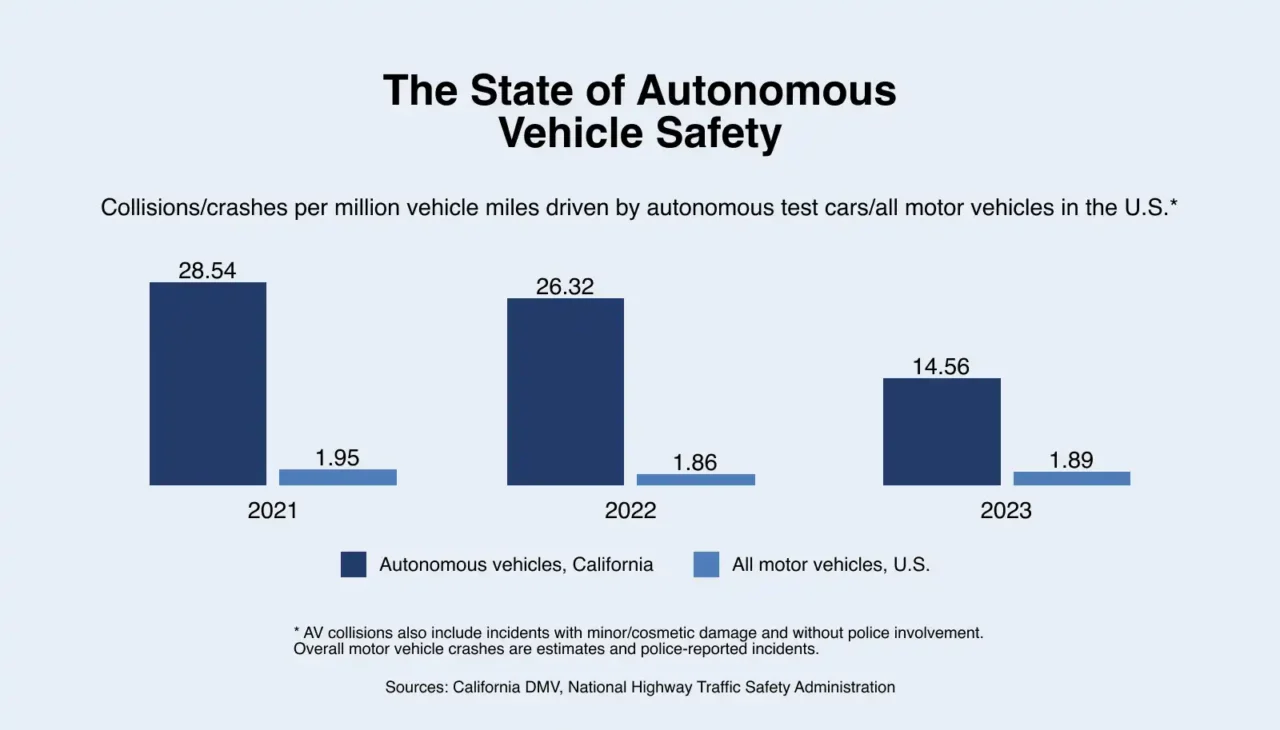
Source: Statista.com
The state stands out in AV reporting because its Department of Motor Vehicles (DMV) runs a dedicated program for autonomous vehicles. The DMV issues permits to companies testing and operating AVs on public roads. While other states have passed laws on autonomous driving, this region remains a major hub for AV development thanks to many leading manufacturers and tech companies based there.
How Many Self-Driving Vehicle Accidents Are There Per Year?
It can be challenging to track the exact number of crashes because the data changes annually. We reviewed NHTSA records on vehicles with Automated Driving Systems (ADS) from July 2021 to December 2024:
| Driverless Vehicle Crash Stats (Source: NHTSA) | |
| Year | ADS-Involved Crashes |
| 2021 | 71 |
| 2022 | 165 |
| 2023 | 288 |
| 2024 | 544 |
| TOTAL | 1,068 |
The number of ADS-related crashes has increased each year as more self-driving vehicles are being tested and used.
While 2024 saw a sharp increase in incidents, it’s important to consider the context. The number of autonomous vehicles on the road has grown as companies like Waymo and Tesla expand their fleets. Self-driving cars used by rideshare platforms such as Lyft and Uber have also become more common. With more vehicles in operation, the rise in reported crashes in 2024 was expected.
Still, safety remains a concern with driverless vehicles. As technology advances, regulations must also evolve to help protect everyone on the road. Car accident attorneys help injured individuals handle the often complicated claims process.
Number Of Accidents Per Vehicle Company
Many companies are developing driverless vehicles. While fully autonomous models are not yet common, ADS incident data helps show how many crashes each company is involved in.
Number Of Incidents Involving ADS-Equipped Vehicles Per Company
The number of ADS-related crashes differs between companies. NHTSA data from July 2021 to April 2025, updated in May 2025, shows the following:
- Waymo LLC — 907.
- Cruise LLC — 155.
- General Motors, LLC — 149.
- Transdev Alternative Services — 138.
- Zoox, Inc. — 81.
These companies reported a significant number of incidents in the data, with Waymo having the highest number. Tesla does not appear on this list because its crashes are counted under ADAS, not ADS. However, since Tesla is one of the well-known companies developing self-driving technology, it’s helpful to look at its numbers for context. During the same period, Tesla reported over 2,000 ADAS-related incidents, prompting questions about how many deaths Tesla has caused in connection with its self-driving technology.
The differences in crash numbers may reflect how many vehicles each company operates, where they run, and the safety measures they follow. However, since we don’t have full data on each company’s fleet size, it is not easy to make direct comparisons.
As companies continue developing self-driving technology, the benefits of fully automated automobiles become increasingly clear, offering exciting possibilities for the future of transportation. Still, safety remains a serious concern until the systems become fully dependable. If a crash involves a driverless car, injury attorneys can help injured individuals understand their legal options, work to identify potentially responsible parties, and pursue compensation in accordance with California law.
Key Risk Factors For Driverless Vehicle Accidents
Many believe self-driving cars could transform transportation. They may help improve accessibility, reduce crashes, and make roads safer. Automation is also reshaping other areas of transportation, with new freight technologies transforming the trucking industry.
However, there are still concerns that these vehicles could also increase accidents. Some risks include:
- Sensor Limitations — Cameras, radar, and lidar may not work well in bad weather or poor lighting, making it harder to detect obstacles.
- Automation Complacency — Drivers might rely too much on automation and react too slowly when they need to take control.
- Cybersecurity Vulnerabilities — Self-driving cars could be vulnerable to hacking or unauthorized access.
- Environmental Challenges — Dangerous road conditions, worn-out signs, and unusual traffic signals can confuse the vehicle’s systems.
- Human-Machine Interaction — Autonomous vehicles may struggle to handle unpredictable behavior from other drivers, pedestrians, or cyclists.
While the technology continues to improve, these risks show why careful testing, strong regulations, and further development are still needed. A key goal is to build systems that can safely handle different roads, weather, and traffic situations.
Car accident lawyers can help you understand your situation and assist you in navigating the legal system if you need to file a claim for these incidents.
Who Regulates Self-Driving Car Safety?
The NHTSA regulates self-driving car safety on a federal level. Generally, it sets the vehicle and highway safety regulations under which self-driving cars would fall. Through measures like the Standing General Order, which requires companies to report crash incidents involving automated systems, the NHTSA maintains its authority to oversee and improve the safety of driverless vehicles. The agency has been actively developing policies related to emerging vehicle technologies, with a focus on:
- Safe Development
- Testing
- Deployment
The agency also assists states in passing legislation when it comes to these types of vehicles. In fact, some states have already enacted their own regulation for automated vehicle development. In California, the DMV regulates autonomous vehicles. They issue permits to manufacturers for testing and deployment. They also allow driverless testing and testing with safety drivers.
Laws regarding autonomous vehicles may vary by state. The National Conference of State Legislatures (NCSL) has compiled information on the legislation enacted in each state. These regulations generally focus on testing, safety, and operation. While specific rules on product liability for autonomous vehicles are still limited, victims may still be able to pursue legal claims if a defect in the vehicle leads to an accident. In general, product liability may apply when there is:
- Design Defect — The design made the vehicle unsafe.
- Manufacturing Defect — There is a manufacturing error that made the vehicle hazardous.
- Failure to Warn — If the vehicle manufacturer failed to provide adequate instructions, it may result in unsafe use.
For instance, how often sensors on driverless vehicles fail can play a critical role in determining who can be held liable after an accident. In such cases, a product liability attorney can work to identify potentially liable parties and help establish negligence. If a product defect contributed to a driverless vehicle accident, a collision lawyer can help investigate the cause. This process may involve examining the manufacturing process, reviewing the components used, and consulting with industry professionals.
Frequently Asked Questions About Autonomous Vehicle Accidents
Our accident lawyers are committed to helping people understand their rights following driverless vehicle accidents. We’ve compiled answers to some frequently asked legal questions about these incidents. For personalized assistance, you can fill out our “Do I Have A Case?” form here. A member of our team will review the confidential information you provide and discuss your specific needs with you.
What Is The Main Cause Of Self-Driving Car Accidents?
There isn’t just one cause. Many crashes occur due to both human error and technological issues.
Self-driving cars use sensors, artificial intelligence, and lots of data to operate. However, even with this technology, accidents can happen if the system doesn’t see obstacles, makes the wrong decision, or struggles in complex situations. Human drivers can also cause problems if they rely too much on the system, misuse the controls, or get distracted.
For example, in one fatal Uber accident, the self-driving car didn’t recognize a pedestrian in time. The safety driver, who was supposed to step in if needed, was distracted and didn’t react. This event shows how accidents can happen when both the technology and the driver fail.
Because driverless car accidents often involve both technology failures and human mistakes, figuring out what caused the crash isn’t simple. Personal injury lawyers can investigate the details, work with professionals, and help identify who may be legally responsible.
Are Self-Driving Cars Safer Than Human Drivers?
There isn’t enough research yet to say if self-driving cars are safer than human drivers. However, early data from Waymo shows that driverless cars may have fewer crashes.
Waymo studied its fully autonomous ride-hailing service, where no human drives or controls the car. These vehicles use Waymo Driver, a Level 4 self-driving system. The study included over 7 million miles driven by the end of October 2023 in Phoenix, Los Angeles, and San Francisco.
The results showed:
- For crashes with injuries, Waymo’s self-driving cars had 0.6 crashes per million miles. Human drivers had 2.8 crashes per million miles.
- For crashes reported to police, Waymo had 2.1 crashes per million miles, while human drivers had 4.68 crashes per million miles.
- Overall, driverless cars had 80% fewer injury crashes and 55% fewer police-reported crashes compared to human drivers.
These numbers suggest that self-driving cars might be safer. At the same time, the study also explains that it’s hard to compare directly because:
- Self-driving cars operate in limited areas under strict rules.
- The vehicles used pre-mapped routes and went through a lot of testing in simulations.
- Real-world driving can differ significantly from controlled test conditions.
More research is needed to confirm this information. For now, accidents can still happen, whether a human or a driverless car is behind the wheel.
Can Self-Driving Cars Ever Be 100% Safe?
Self-driving cars may never be completely safe. Making anything fully safe is very difficult. Research from the Insurance Institute for Highway Safety (IIHS) shows that even when safety is the main focus, driverless cars might only help prevent about one-third of crashes.
The other two-thirds often happen because of speeding and other forms of reckless driving, which human drivers often cause. Even with automation, accidents can still occur due to system errors or the unpredictable actions of other drivers, pedestrians, or cyclists.
Mechanical problems, like tire blowouts or brake failures, can also result in crashes, no matter who is driving. Because of these challenges, self-driving technology still has more work ahead. Until it can handle complex real-world situations, safety concerns will continue.
Who Is Liable In An Autonomous Vehicle (AV) Accident?
Liability in driverless car accidents depends on what caused the crash. Even with self-driving features, drivers must stay alert because no vehicle today is fully autonomous.
Many AVs still have safety drivers during testing. Fully driverless cars, like Waymo’s Level 4 vehicles, operate only in certain pre-mapped areas without human drivers or remote control. These systems rely on strict safety rules to operate on public roads.
When an accident happens, more than one party may be held responsible. Possible liable parties include:
- The safety driver (if present).
- The manufacturer.
- The system or software designer.
- Parts or sensor makers.
- Repair or maintenance providers.
Accidents may involve system errors, defects, or human mistakes. Because these cases can be complicated, having legal guidance is important. Attorneys for car accidents can investigate the crash, review evidence, and work with experts to identify potentially responsible parties.
Do I Need A Personal Injury Lawyer After An Accident With A Driverless Vehicle?
You can file a claim on your own, but accidents involving self-driving cars are often complicated. Figuring out who is responsible can be tricky, and without legal help, you might not be able to seek the full extent of your losses. This may result in a settlement that falls short of covering your full financial and medical needs after the accident.
Compensation may cover medical bills, lost wages, property damage, and pain and suffering. Medical costs can include emergency care, doctor visits, prescriptions, physical therapy, or chiropractic treatment, depending on the nature and severity of your injuries.
It can be hard to calculate the damages available in a claim. A personal injury attorney can help identify all possible damages, represent your interests, and connect you with medical providers to assist with your treatment and support your claim.
How Much Will It Cost To Hire An Attorney For Driverless Car Accidents?
Many lawyers handling personal injury cases, including ours, charge zero upfront costs and instead work on a contingency fee. You only pay attorney’s fees if your case reaches a settlement or verdict, and the amount you pay will be taken from a percentage of the total compensation obtained. If there’s no compensation, you won’t owe us for our legal services. Other case-related costs will be charged separately, regardless of the outcome.
The percentage that the lawyer typically takes can vary depending on the complexity of the case and whether it proceeds to trial. Some law firms cover certain costs upfront and deduct them later from your payout.
Every case is different, so it’s important to discuss fees during your initial consultation. Your injury lawyer will explain all costs before you sign an agreement.
What Should I Do If I’m Injured In A Driverless Car Crash?
If you’re involved in an accident with an autonomous vehicle, taking certain steps can make an impact on any potential legal claim:
- Prioritize Medical Attention — Get your injuries checked and evaluated. Seeing a doctor initiates proper treatment and documents both your medical expenses and the severity of your injuries. Car crash attorneys often highlight the importance of this step in supporting your claim.
- Document Extensively — If possible, save any photos or videos you or others took at the scene, including damage to vehicles, road conditions, traffic signals, and visible injuries. Keep records of the autonomous vehicle’s make, model, and any identifying details about the operator or company.
- Gather Information — Keep contact information you collected from any human operators, company representatives, witnesses, and police officers. Request a copy of the police report if you have not received one.
- Preserve Evidence — Keep all medical records, repair estimates, and correspondence with insurance companies or autonomous vehicle operators. Lawyers who focus on accident claims can also assist in gathering other pieces of evidence that are harder to get, such as traffic surveillance footage or company records.
- Avoid Discussing Fault — Limit your statements about the accident, particularly when speaking with insurance representatives.
- Consult a Lawyer — Autonomous vehicle accidents involve complex questions of liability that may differ from conventional vehicle accidents. A personal injury attorney who understands this area can help address the challenges that may arise and guide you through the claims process.
Acting promptly and thoroughly documenting the incident can help you navigate the process more efficiently.
Know Your Rights With The Help Of Our Self-Driving Car Accident Lawyers
Self-driving technology aims to make driving safer and more convenient, but people disagree on how quickly to adopt it. As technology advances, safety remains a major concern. Lawmakers are creating new rules to help protect everyone on the road. Lawyers for accident cases work to stay up to date with these regulations in order to assist victims of collisions.
Accidents involving self-driving vehicles can be more complicated than regular car crashes. Identifying potentially responsible parties can be a challenging task. If you sustain injuries in one of these accidents, a car accident attorney who understands this area can help explain your options.
The personal injury lawyers at the AK Law Firm can guide you through the legal process and help you explore your next steps. Contact us at (888) 488-1391 to schedule a free initial consultation and discuss your case.

